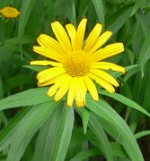 Willowleaf oxeye is clump forming herbaceous perennial native to Europe and a member of the aster family, Asteraceae, that also includes goldenrod, lettuce, and daisies. With long narrow unscented leaves resembling those of a weeping willow, this oxeye bears solitary, terminal yellow flowerheads two inches across in late summer. The flowerhead consists tubular yellow disc flowers surrounded by yellow ray florets with two to four teeth at the tips. The stems are erect but slender and plants need staking. Willowleaf oxeye is a good choice for cottage gardens, and informal wildflower gardens as well as areas with poor soil. That is well drained and in full sun. The flowers are suitable for the vase. The genus name, Buphthalmum comes from the Greek words bous, meaning ox, and optalmos, meaning eye in reference to the appearance of the disc of the flower head. The specific epithet, salicifolium, comes from the Latin words Salix, the name for willow, and folia meaning leaf, and refers to the willow-like appearance of the foliage.
Willowleaf oxeye is clump forming herbaceous perennial native to Europe and a member of the aster family, Asteraceae, that also includes goldenrod, lettuce, and daisies. With long narrow unscented leaves resembling those of a weeping willow, this oxeye bears solitary, terminal yellow flowerheads two inches across in late summer. The flowerhead consists tubular yellow disc flowers surrounded by yellow ray florets with two to four teeth at the tips. The stems are erect but slender and plants need staking. Willowleaf oxeye is a good choice for cottage gardens, and informal wildflower gardens as well as areas with poor soil. That is well drained and in full sun. The flowers are suitable for the vase. The genus name, Buphthalmum comes from the Greek words bous, meaning ox, and optalmos, meaning eye in reference to the appearance of the disc of the flower head. The specific epithet, salicifolium, comes from the Latin words Salix, the name for willow, and folia meaning leaf, and refers to the willow-like appearance of the foliage.
Type: Herbaceous perennial
Bloom: Solitary, terminal yellow flowerheads two inches across in late summer
Size: 1-2’ H x 2’ W
Light: Full sun
Soil: Tolerates poor soil that is well drained
Hardiness: Zones 3-7
Care: Deadhead to prolong bloom
Pests and Diseases: None of significance
Propagation: Seed, division in early spring or immediately after flowering
Companion plants: Russian sage, blanket flower, black eyed Susan, stonecrop